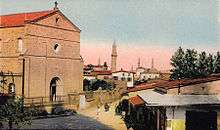Catholic Church in Cyprus


The Catholic Church in Cyprus is part of the worldwide Catholic Church, under the spiritual leadership of the Pope in Rome.
Description
There are around 10,000 Catholic faithful in Cyprus, corresponding to just over 1% of the total population. Most Catholic worshippers are either Maronite Cypriots under Joseph Soueif Archeparch of the Maronite Catholic Archeparchy of Cyprus, or Latins, under the Latin Patriarch of Jerusalem, with a Patriarchal Vicar General. The Latin Patriarchal Vicariate for Cyprus (Latin Catholic Church of Cyprus) has four parishes:
- Nicosia Holy Cross church, which maintains a mission at St. Elizabeth Catholic Church in Kyrenia in the Turkish-controlled territories.
- Larnaca St. Mary of Graces Catholic Church
- Limassol St. Catherine Catholic Church
- The Sisters of St. Bruno and Bethlehem have a small convent at Mesa Chorio served by the parish priest of Paphos. A recently constructed hospice for palliative care, regardless of nationality or religious persuasion extends the works of charity of the Catholics in Cyprus, providing a valuable witness to the Culture of Life as the European Union enters a new phase of growth and development.
- British Sovereign Base Areas There is also a Catholic presence by chaplains serving British military personnel, staff and dependents in the sovereign base areas of the island that were excluded from the territory taken over by the Republic of Cyprus at its independence from the UK in 1960. Permanent Catholic chapels exists and public masses are celebrated in English.
Sacred sites in Cyprus
Many of the religious sites in Cyprus can be traced to early Byzantine foundations, built before the Christian schism between the Latins and New Rome in the 11th century. Their architecture and iconography reveal a profound influence on ecclesial building traditions still in use in modern times, further examples are listed under Cypriot Orthodox Church. In the Middle Ages, Cyprus was ruled by a Frankish aristocracy, the Lusignan dynasty. They favored the Gothic style when establishing cathedrals and monasteries. The former Roman Catholic Augustinian Cloister named Bellepais near Kyrenia was transferred to Orthodox Church authorities when the Ottomans conquered Cyprus at the close of the 16th century. Other Gothic churches were converted to mosques, for example Saint Sophia Cathedral (now Selimiye Mosque (Nicosia) and Saint Nicholas Cathedral in Famagusta, now the Lala Mustafa Pasha Mosque.
Religious freedom in Cyprus
The Catholic Near East Welfare Association (CNEWA) reports that ecumenical collaboration holds signs of promise and hope for religious freedom in the northern Turkish occupied territory of this divided island, for example the 1994 celebration of the Eucharist at St. Andrew monastery on the Karpass peninsula, the first in 20 years. The Permanent Mission of Cyprus to the UN traces the political representation of Catholics in Cyprus to the conciliatory work of the last British Governor, Sir Hugh Foot, who brokered a conflict between Roman Catholics and Maronites by coining the term Latins for voter registration purposes during drafting of the Constitution of the newly independent Republic.
